Westpac: It’s a two-speed house market! AMP: It’s simpler. There’s more Australians than homes
There is now a clear ‘two-speed’ property price growth duality across Australia’s major capital cities, as others outpace Sydney and Melbourne, says Westpac.

There is now a very clear “two-speed” property price growth duality splitting time and space … and mainly money across Australia’s major capital cities, according to Westpac’s senior economist Matthew Hassan.
On the one hand we have slowing gains for the usual hotshot cities of Sydney and Melbourne – the Vic capital’s price growth momentum has been all but shirt-fronted of late – against the accelerating rises in Brisbane, Adelaide and Perth.
For the latest property news, sign up here for free Stockhead daily newsletters
Those last three cities are all commanding growth at “double-digit” annualised rates, according to property data firm CoreLogic.
The company’s latest home value index, covering the country’s eight major capital cities, rose by 0.6 per cent in April 2024, the same pace as both February and March.
It was the 15th consecutive monthly gain in home prices, taking the total price growth over that period to 12.2 per cent.
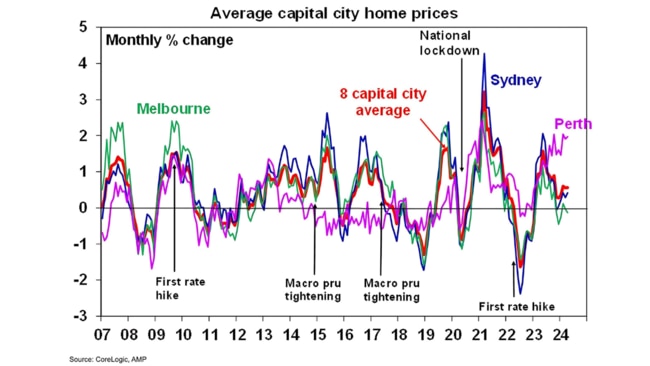
As Hassan says, it wasn’t the country’s headline cities that set the pace, but rather the mid-sized capitals.
Perth again rose briskly, rising by 2 per cent.
There are signs growth in Brisbane is moderating, rising by 0.9 per cent in April, the slowest pace in 12 months.
Adelaide rose by 1.3 per cent.
Smaller capital cities including Hobart (+0.3 per cent), Darwin (+0.6 per cent) and Canberra (+0.2 per cent) recorded small gains.
Overall, the April update is again a bit unclear on whether price momentum is showing a slight lift or fading, says Hassan.
“What is clear however is the diverging performance across markets with conditions softening in Sydney and Melbourne but upturns still powering ahead in Brisbane, Adelaide and Perth,” he said.
“There is a similar ‘two-speed’ picture on turnover, sales in Sydney and Melbourne down 9.8 per cent over the three months to April but up 1.5 per cent across the other major capitals on a combined basis.
“The detail also continues to show a contrasting performance across tiers, top tier sub-markets weaker than others in Sydney and Melbourne but outperforming in Adelaide and Perth.”
Sydney prices rose by 0.4 per cent over the quarter, a small lift on the 0.3 per cent gain over the in March quarter and the flat outcomes recorded between November and January.
MORE FROM STOCKHEAD: Why health sector has a different flavour | ASX quarterly health wrap | Medtechs bracing for vital catalysts Part 1 | Part 2
But then again …
However, as CBA’s Belinda Allen argues, the gains in Sydney are strongest outside of the top quartile of property values.
So Sydney’s cheaper parts are still bustling, unlike Melbourne.
“Melbourne continues to record weaker outcomes, falling by 0.1 per cent in April with prices lower over the past six months,” she said.
“Changes to land tax in Victoria could be providing a headwind.”
Within the second group, the pace of price rises has moderated in Brisbane (+0.9 per cent over the month, +16.1 per cent across the year) but lifted a little in Adelaide (+1.3 per cent for the month, +14.0 per cent for the year) and remains very strong in Perth (+2.0 per cent and +21.1 per cent).
Annual price growth is tracking slightly behind the national pace in Sydney (+0.4 per cent across the month, +8.7 per cent for the year) and is materially slower in Melbourne (–0.1 per cent, 2.8 per cent).
Across the smaller capitals: Hobart recorded a 0.3 per cent rise in the month but with prices still down slightly over the year (–0.4 per cent for the year); Canberra prices rose 0.2 per cent to be up 2.1 per cent over the same period; and Darwin recorded a slightly firmer 0.6 per cent gain to be up 1.9 per centyr.
Across regional areas, prices were flat in regional Vic, up 0.6 per cent in regional NSW and posted a stronger 1.1 per cent gain in regional Queensland (which includes the Gold and Sunshine Coasts).
Making a house call
Shane Oliver, chief economist and head of investment strategy at AMP, says it’s pretty clear exactly where the national property market is: “Caught between high rates and the extreme housing shortage, with the latter dominating.”
He says the big negative influence on the property market remains two problems – poor affordability and high mortgage stress.
“For decades property prices were supported by ever lower interest rates but due to the rebound in interest rates from May 2022 and high home price to income ratios there is now a wide divergence between buyers’ capacity to pay for a property and current home prices – with the capacity to pay down by nearly 30 per cent on our estimates over the last two years,” he said.
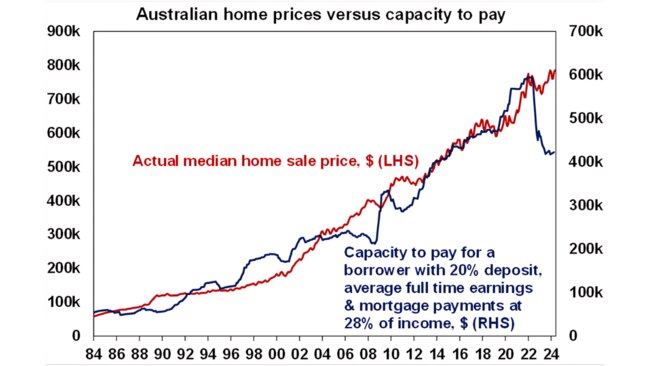
In the absence of rapid interest rate cuts this continues to point to a high risk of lower property prices ahead, Oliver said.
“This is reinforced by ultra-low sentiment towards property. A sharp rise in unemployment in response to weak spending in the economy would add to the downside risks flowing to property prices from high rates.”
Against this though is the chronic housing shortage which got the upper hand over the past year as immigration levels surged.
“Put simply the surge in population growth to a record 660,000 over the year to the September quarter last year driven by record immigration levels meant that around an extra 250,000 new homes needed to be built,” Oliver said.
“But instead completions have been running around 170,000 as the home building industry struggled to keep up with rising costs and material and labour shortages and as approvals to build new homes fell.
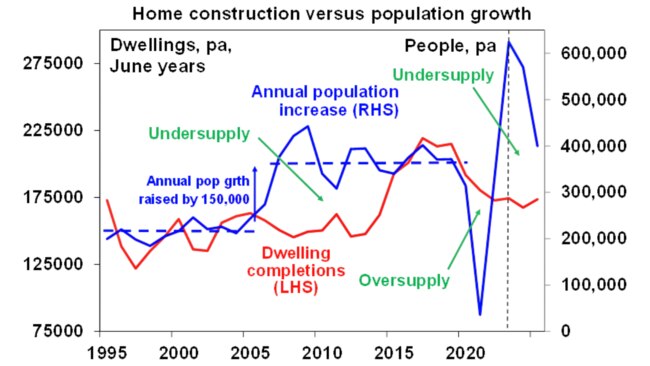
According to Oliver, the shortfall of homes has just expanded by another 70,000 or so dwellings and is expected to see the accumulated shortfall rise to around 200,000 dwellings by June this year.
“Which is itself a conservative estimate,” he assured.
While prices nationally pushed above their 2022 peaks late last year and are now 3 per cent higher, prices are still 6.2 per cent below these levels in real, inflation adjusted terms.
Search for true north on price growth
Hassan said there continued to be a notable divergence between monthly trends reported in the headline, non seasonally adjusted, measure and CoreLogic’s seasonally adjusted estimates.
“Ordinarily there is little different but currently the seasonally adjusted measures suggest momentum is continuing a gradual fade that began in mid-2023 rather than lifting slightly,” he said.
“These doubts should clear as we move into the second half of the year and seasonal price effects turn slightly negative.
“In the meantime, annual growth rates provide a ‘sense-check’ that is unaffected by these issues.”
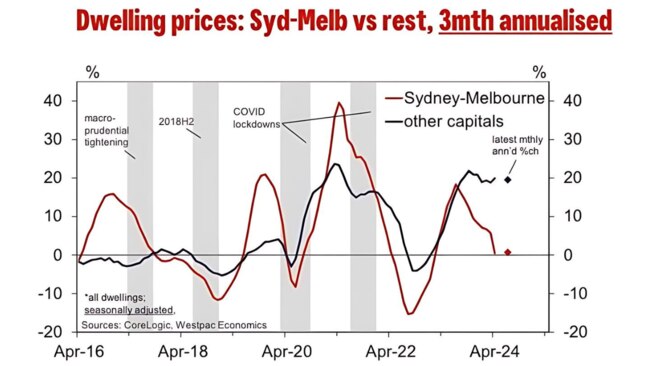
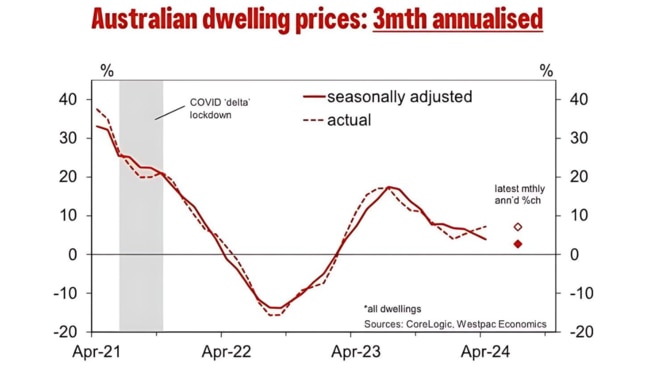
There continues to be a notable divergence between monthly trends reported in the headline, non-seasonally adjusted, measure and CoreLogic’s seasonally adjusted estimates.
Ordinarily there is little different but currently the seasonally adjusted measures suggest momentum is continuing a gradual fade that began in mid-2023 rather than lifting slightly.
These doubts should clear as we move into the second half of the year and seasonal price effects turn slightly negative. In the meantime, annual growth rates provide a ‘sense-check’ that is unaffected by these issues.
Visit Stockhead, where ASX small caps are big deals
What lies ahead then, Belinda?
The pace of gains across the first four months of the year has been a little stronger than CBA anticipated.
Strong demand, despite lower borrowing capacity and rising affordability challenges, as well as continued supply constraints have continued to push momentum in the housing market, says Allen.
“Talks of interest rate cuts earlier in the year could also have provided a boost,” she said.
And now that chatter flipped after the US Federal Reserve’s rates call.
“Due to stronger than expected non‑discretionary inflation, we have now pushed back the start of the RBA easing cycle,” said CBA lead economist Gareth Aird.
“We now expect the first rate cut in November, compared to September and only one rate cut this year, rather than three,” said Allen.
“A shallower easing cycle this year could see less upward impact on home prices late 2024, reducing, but not eliminating the risk of home prices this year exceeding our 5 per cent forecast.”
What’s pretty clear is that the leading indicators of Aussie home prices right now are mixed.
Allen said auction clearance rates were still above where they were in late 2023, while lending and sentiment remained a tailwind.
She said the reprieve from strong home price growth would have to come from the supply side.
“A lift in listings, as well as new housing supply will help, but as we have seen new building approvals are constrained due to challenges in the construction space and crowding out from government and other forms of private investment.”
This content first appeared on stockhead.com.au
SUBSCRIBE
Get the latest Stockhead news delivered free to your inbox.Click here


